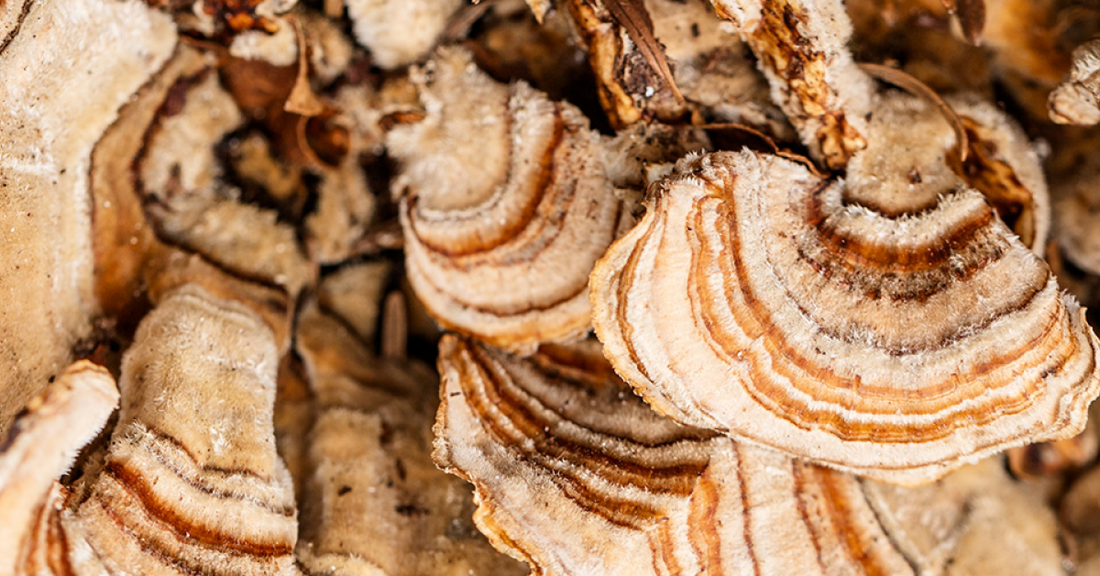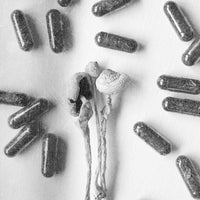Hello, I’m Matt; Food Scientist and MUD\WTR’s Director of Research and Development.
In your search for mushrooms and coffee alternatives, have you heard things like “extracts are the best,” “mycelium is filler,” “10:1 extract means 10x more potent,” or “MUD\WTR is just a bunch of oats”? Much of these are fabricated sales tactics based on industry science that was outdated 40 years ago, and I’d like to take this opportunity to spread some truth. Extract industry giants have stewed in antiquity and sling mud (not the good kind) through baseless claims and fiction instead of progressing mushroom science forward, and this is damaging for all of us.
I’d like you to join me on a journey to showcase the benefits of full-spectrum fruiting body and mycelium mushrooms in MUD\WTR products while putting to bed some of the fiction spread about them. Using science! And pictures!
Does MUD\WTR Have Oats In It?
Much of the deception comes around the use of “full-spectrum” mushrooms in our products. You’ll hear, “It’s not really a mushroom, it’s all oats or oatmeal, it’s not efficacious.” You’ll see pictures like the following, some oats with some white goop around them, claiming these are the “mushrooms” we use:

Photo courtesy of nammex Organic Mushroom Extracts from their public FDA petition.
When in reality, the full spectrum mushrooms we use look like this:

Lion’s Mane, Cordyceps and Reishi, photos courtesy of M2 Ingredients

Here’s a picture of me holding a bag of cordyceps from the production room at M2. It was so beautiful that I wanted to take it home with me.
Definitely looks like a bunch of oats, right? right guys? We have been accused of being ignorant or lied to by M2. So we wanted to share that we have been to their facilities multiple times. We’ve evaluated their processes and products and we’ve seen, with our own eyes, the form of full-spectrum products. All this to say, we’ve done the research required to ensure that we’re using high-quality ingredients rather than simply spewing some skeevy competitor marketing lingo about ingredients we don’t actually know anything about.
Are Extracts Better Than Full Spectrum Mushrooms?
We are big fans of extracts as much as full-spectrum mushrooms at MUD\WTR when they are a high-quality product. There is so much more to the quality and benefits of a mushroom than its processing method; there are great and poor extracts as much as there are great and poor full-spectrum products.
The word “extract” does not automatically make a product efficacious, nor does “fruiting body,” and here’s the proof.
Hericenones, hericerins and erinacines are some of the most researched bioactive compounds found in Lion’s Mane that impart a cognitive benefit by supporting nerve health across our nervous system. Hericenones and hericerins are found more concentrated in the fruiting body, while erinacines are more concentrated in the mycelium.
Using high-precision mass spectrometry, M2 looked at the relative concentrations of these compounds in the Lion’s Mane used in MUD\WTR vs. a leading extract, and the results were astounding.

We were expecting to see our product contain significantly more erinacines due to the inclusion of mycelium, but we did not expect the extract to be so low in the compounds found typically in the fruiting body. Not only does this support the use of full spectrum Lion’s Mane, but it goes to show there’s a lot of hot air in extract marketing. The blanket statement of “fruiting body extracts are superior” is clearly not the case when the manufacturer does not put quality first in their growth, strains and manufacturing process.
These graphs represent the relative ratios of the compounds on a 1:1 basis. For example, if you had 1 gram of the extract and 1 g of the full-spectrum product, you would expect the concentration of these compounds to be present in the ratios graphed. At this time, high-resolution mass spectrometry is unable to determine the total amount of each compound without the use of standards, but it can be compared between two samples.

To drive this home, we also looked at the relative abundance of cordycepin, a primary bioactive compound found in cordyceps that is responsible for supporting natural energy produced in our body. Results are to the right. Again, pretty staggering …
All this is not just to demonstrate the quality of our mushrooms, but to speak to how fictitious the blanket term “extracts are better” truly is. If a grower doesn’t prioritize quality and put effort into strain maintenance and continuous improvement, then it doesn’t matter if it’s extracted or not—it will not be a good product.
Last, it’s important to note that while we don’t want to name and shame the extract used in this study, this isn’t some rinky-dink, fell-off-the-truck extract; this extract comes from a global supplier of extracts and can be found in many consumer product goods.
What Is a Mushroom Extract Ratio?
You will see a lot of hand-waving in marketing around extract ratios. Products may only contain 100 mg of an extract, but because it’s a 10:1 extract, they will say it really contains 1,000 mg. Without measuring the active biomarkers, the ratio does not indicate the quality of an extract. So, what does the ratio mean?
By itself, the ratio means that it took 10 parts of the starting material to make 1 part of the finished product. Say you made 100 lbs of a 10:1 extract, This means that you would have started with 1,000 lbs of raw materials. That’s it—it’s simply a way to state the efficiency of a process.
The only way to determine how efficacious an extract is, is to measure active biomarkers like we have done in the previous section. The extraction process can be a very harsh processing step and includes high heats and solvents. You need to turn a liquid into a powder and that takes a lot of energy. Many compounds in mushrooms are heat sensitive, so you have the potential to denature compounds while you try to extract them, lowering the efficacy even further. On top of this, most extract makers will use sneaky processing aids in the form of acacia gum, maltodextrins and other starches (or worse), but they don’t label them. These ingredients are usually necessary to spray dry liquids into powders. And they really are “fillers” that reduce the amount of mushroom even further.
A great whitepaper was recently written by M. Monagas and others about why using the extraction ratio as a marketing ploy is a poor deception. Here’s a relevant quote:
...it is necessary to disclose not only the plant-to-extract ratios, but also to include the complete botanical extract composition, including any excipients and their percentage in the extract, extraction solvents, and the amount of active or marker constituents. In the absence of this information, the use of plant-to-extract ratios to calculate relevant raw materials should be considered with caution.
The extract ratio is a fine inform, but be dubious of products that claim to have a large quantity of mushrooms or any botanicals by using some multiplication.
Does MUD\WTR Contain Mycelium?
We certainly do, and we are proud of it! MUD\WTR products contain both fruiting body and mycelium (together called the ‘mushroom’) because it’s very clear there are benefits.
Studies suggest the efficacy of mycelium comes in many forms; for example—Reishi mycelium shows antioxidant properties, and the mycelia is shown to support immune system functionality. Additionally, there are important proteins and other macro compounds that are typically discarded in extracts but are present in full-spectrum products. Turkey tail mycelia is well-researched in supporting immune function, including when it is grown and used in the same way as our mushrooms. It’s also important to consider mycelium when using Lion’s Mane due to the inclusion of erinacines as well as Cordyceps mycelium which is shown to impact tolerance to high-intensity exercise. There’s plenty more out there if you choose to research. I highly recommend the book Medicinal Mushrooms by Dr. Christopher Hobbs.
Disclaimer: The linked studies are not used as claims of the benefits of MUD\WTR. They are simply used as informational evidence of mycelium efficacy. In no way should the results of these studies be misconstrued as MUD\WTR product claims.
What About Chaga Fruiting Bodies?
Just a PSA: beware of companies that claim to use Chaga “fruiting bodies,” as this demonstrates a clear lack of mycological understanding and calls into question other claims they may make. Chaga conks are composed of mycelium and birch. You’ll even find major coffee alternative websites that say, “Avoid Chaga mycelium,” which is an absurd statement to make about their own products, considering what Chaga conks are.
The Benefits of MUD\WTR’s Full-Spectrum Mushrooms
If you weren’t convinced by the scientific literature on the importance and efficaciousness of mycelium; along with the previous information about our Lion’s Mane and Cordyceps active component measurements, we have several sets of data to demonstrate more benefits. The following information applies specifically to full spectrum mushrooms used in MUD\WTR and produced at M2 ingredients. Not all sources will have these same standards.

Blueberries, especially their extract, are considered to be an excellent source of antioxidants.
We measured the bioavailable antioxidant capacity of our Lion’s Mane and Cordyceps and found that Lion’s Mane had an equal antioxidant capacity to blueberries, and Cordyceps exceeded it.

In a cell-based study, cells were treated with low doses of both our Lion’s Mane and Cordyceps. They were found to have a statistically significant increase in energy production in the mitochondria compared to baseline cells. Cells become less efficient in producing energy as part of the aging process, so it is important to find ways to keep them running efficiently. Contrasted to caffeine, this is truly enhancing natural energy vs. caffeine’s faking our body into thinking it has energy.
In a clinical trial using the Cordyceps found in MUDWTR, improvements in both VO2max and sports performance in a clinical setting were found, allowing for increased time to exhaustion vs. a placebo.

In a pre-clinical trial, both Reishi and Turkey Tail found in MUD\WTR products were found to have immunological benefits which aligns with the scientific literature reported previously. Reishi showed robust anti-inflammatory properties by down-regulating pro-inflammatory cytokines in inflamed cultures as well as supporting the production of stem cell-mobilizing growth factor. Turkey Tail had highly selective effects under inflamed conditions. This pre-clinical trial sets the groundwork for a clinical trial to continue to display the incredible immunopotentiating benefits of these fungi.
MUD\WTR Mushrooms Conclusion
What makes a mushroom product good or bad isn’t nearly as simple as extract vs. full spectrum, or fruiting body vs. mycelium. As we’ve demonstrated, what makes a mushroom quality is the amount of knowledge and research put into progressing a product forward and building to the best standards. We recognize there are good and bad players in the extract and full-spectrum world, and to blanket label any product simply by the method of preparation is a poor decision.
We know (and use) really great extracts and we stand behind the quality of the mushrooms that our mushroom partner M2 grows. I hope this page helps to demonstrate that.
If you’ve made it this far, thank you. Please feel free to reach out to us at drink@mudwtr.com if you have any questions or concerns. We’re always happy to talk mushrooms.
Love,
Matt Director of R&D




